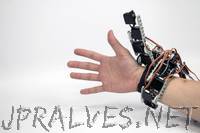
“We envision a machine-driven evolution of human body form and function, where the programmable nature of machines plays a crucial role. Robotic joints worn on the wrist turn into extra fingers so that a person acquires skills beyond what five fingers can offer, or performs ‘tri-manual’ tasks with the machine joints.”
